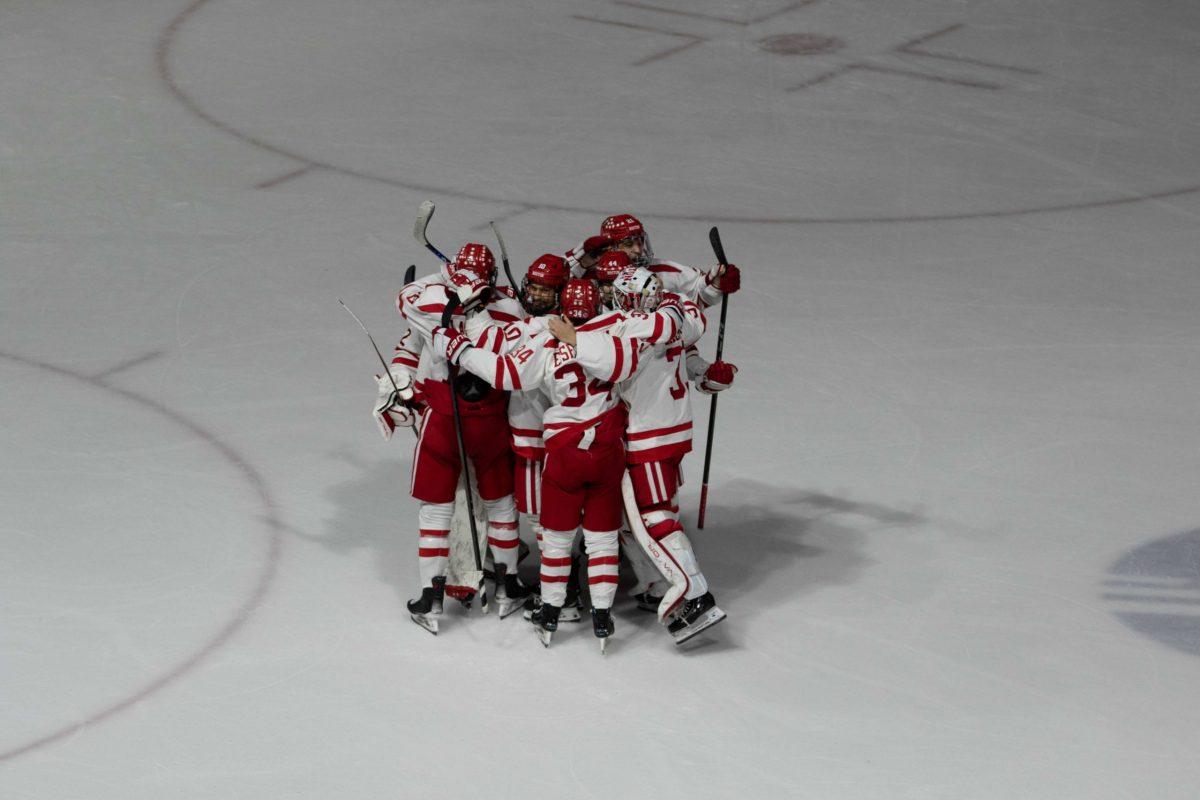
Photo by Cristina Romano.
IN A SEASON MARKED BY SHIFTING LINES, the Boston University men’s and women’s hockey teams proved that adaptability breeds success — culminating in dual NCAA tournament appearances.
The women’s team clinched an NCAA tournament berth with a historic Hockey East championship, its first in a decade. The men’s team earned an at-large bid and rode that momentum to the national championship game, where it ultimately fell to Western Michigan.
Their journeys to the NCAA tournament took distinct routes. The women surged early in the season, asserting dominance in Hockey East and building a compelling underdog narrative. The men, meanwhile, maintained a high national ranking but struggled with consistency before hitting their stride in the latter half of the season.
Both teams, however, shared a common theme: frequent line changes characterized their seasons.
Coaches leaned into rotation, searching for chemistry, balance and fresh energy throughout the season.
The result was a dynamic style of play, one that kept players adapting.
For the women’s team, the principle of line changes moved well beyond finding good fits, but rather how the team as a whole defined success.
“Just because you win doesn’t mean you should keep the lines together,” said women’s coach Tara Watchorn.
The Terriers opened last season with nine wins in their first 12 games, including an eight-game winning streak. While their record held steady, their lines were anything but, constantly shifting in search of the right chemistry.
Over those 12 games, the lineup was altered in nine instances, meaning that 75 percent of the time, players competed in different configurations, irrespective of the game’s outcome.
“It comes back to how you define success,” Watchorn said. “You’re showing them that it’s a tangible way, you’re showing them that it’s not just about winning a game.”
Heading into the 2025-26 season, the women’s team faces a transitional period after graduating 10 upperclassmen — seven of whom played major roles last year.
While returning contributors like Luisa and Lilli Welcke, Riley Walsh and Sydney Healey provide a strong foundation, the loss of most of the defensive core means the team may need time to recalibrate.
The season is unpredictable, Watchorn explained. “I think they took pride in knowing that [line changes] didn’t stress us out down that stretch,” she said.
For example, in the Hockey East playoffs, Sydney Healey and Riley Walsh switched between the first and third lines because their opponent “demanded a different field depending on the game,” Watchorn explained.
If the team was not seasoned with line changes, they would not have been able to make that change late in the playoffs.
With a roster in flux and new faces stepping into critical roles, the ability to pivot, whether through line changes or embracing unfamiliar pairings, will be essential. As the season unfolds, that same resilience and willingness to evolve could prove to be their greatest asset.

On the men’s side, BU returns a young roster, with 20 underclassmen, 12 of whom are freshmen.
The Terriers had a young and inexperienced roster last year, a fact that may have contributed to their frequent penalties and struggles for consistency in the first half of the season.
These struggles came to a head when BU lost to Yale, 7-5, before the new year.
The most significant lineup adjustment came in the second semester with the introduction of freshman goaltender Mikhail Yegerov. While the new face between the pipes provided stability in net during the latter half of the season, line combinations continued to fluctuate until the NCAA regional final against Cornell. Only in that game and the two at the Frozen Four did the lines remain consistent.
Out of 42 games played, including exhibitions, only eight games featured unchanged line combinations, meaning players were shuffled in roughly 80 percent of the matchups.
With such a young squad — specifically, with a ton of new forwards — coach Jay Pandolfo thinks they will be “doing some experimenting” to find the correct chemistry of players.
Pandolfo, however, does not seem worried about the addition of the younger players affecting team chemistry.
“I like the way practices have looked from a competitive standpoint,” Pandolfo said. “It doesn’t seem like the younger guys are intimidated, that they are willing to compete. And I think that goes a long way when you see that right off the hop.”
Though a young roster may be a concern to outsiders, Pandolfo’s roster is built on versatility. Two-way forwards, defenders who can jump into the rush and players who generate offense, creatively. Each player has the ability to adapt, and has to with the level of talent on the team.
This season brings fresh faces, new questions and plenty of uncertainty. But if last year offered any glimpse of the future, it’s that the Terriers are at their best when the pieces keep moving, and when change itself becomes their constant.
Editor’s note: This story is part of the Daily Free Press’ annual Hockey Issue. Physical copies are available around campus starting Friday, October 3rd and will be handed out at both the men’s and women’s home openers.